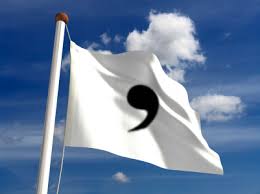 Purdue says, “Use a comma near the end of a sentence to separate contrasted coordinate elements…” https://owl.english.purdue.edu/owl/owlprint/607/.
Purdue says, “Use a comma near the end of a sentence to separate contrasted coordinate elements…” https://owl.english.purdue.edu/owl/owlprint/607/.
Like so many definitions, this one needs some explanation for it to actually make sense.
As covered in More than One Adjective–Comma or No Comma, adjectives can be sorted into groups as to the expected order to be used in sentences.
1. quantity or number
2. quality or opinion (judgement)
3. size
4. age
5. shape
6. color
7. proper adjective (often nationality, other place of origin, or material)
8. purpose or qualifier
It looks a lot harder than it actually is, at least if you’re a native English speaker, since we mostly do it unconsciously. (If you had to learn English as a second language, I have nothing but respect for your dedication.) At any rate, if adjectives are in the same category, they’re coordinate.
We covered what happens when the adjectives are right next to each other, but sometimes adjectives, or a phrase that does the same job, can be added at the end for greater effect. This can be done with any of the above categories.
- The watchers were numerous, too many to avoid.
- His defense was ludicrous, even childish.
- Our national debt is vast, beyond our ability to picture without visual aids.
- “I’m six, almost seven.”
- The stain was irregular, much larger than what would be made by a leaky red pen.
- Her eyes were reddened, bloodshot with tears.
- Her dress was silk, or possibly rayon.
- He was built like a lineman, unstoppable.
The other use that Purdue gives is to indicate a distinct pause or shift. I think of it as the salesmanship technique because it’s so often used to great effect by them. It’s those little rhetorical questions that are thrown on at the end of sentences, usually to get you to agree. (Look out if it’s followed by something you don’t want to agree with.)
- Parents all want their children to be well-educated, don’t they?
- I thought he was very rude, didn’t you?
- He’s almost seven, isn’t he?
I hope this helps with the continuing quest of better comma usage. It’s a surprisingly complex piece of punctuation. 🙂
***





Oh, I absolutely love the intimate details of punctuation. My biggest frustration is that nearly all grammar texts read like stereo instructions for language.
Thank you for simplifying the grammar rules and showing examples, Cathleen. I appreciate the repository, here, and I will return. 🙂
LikeLiked by 1 person
Hurray! It’s helping someone else. I had to write these things in order to get something I could use. When I taught, the kids and I would do the “textbook to English translation” so that everyone would understand what was being explained. Otherwise we had information but no way to use it.
LikeLike
[…] “Using a Comma for Contrast or Effect” […]
LikeLike
“I don’t always use a grammar book, but when I do, I use my Strunk and White.” – me
It is hard to mix grammar and humor. They are like oil and water. You need an emulsifier. Elements of Style has humor like your post here. I really enjoyed it.
Thanks for putting it out here.
LikeLiked by 1 person
You’re very welcome. Anything for a fellow Elements of Style admirer. 🙂
LikeLiked by 1 person